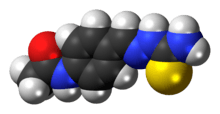Thioacetazone
 | |
 | |
| Systematic (IUPAC) name | |
|---|---|
| N-{4-[(ethanethioamidoimino)methyl]phenyl}acetamide | |
| Clinical data | |
| AHFS/Drugs.com | International Drug Names |
| Oral | |
| Identifiers | |
| 104-06-3 | |
| J04AM04 | |
| PubChem | CID 9568512 |
| ChemSpider |
7843221 |
| UNII |
MMG78X7SSR |
| KEGG |
D08584 |
| ChEMBL | CHEMBL375492 |
| Synonyms | N-[4-[(carbamothioylhydrazinylidene) methyl]phenyl]acetamide |
| Chemical data | |
| Formula | C10H12N4OS |
| 236.3 | |
|
SMILES
| |
| |
| | |
Thioacetazone (INN and BAN) is also called thiocetazone, thiacetazone, thiosemicarbazone, benzothiozane or amithiozone (USAN); abbreviated T.
Thioacetazone is used in the treatment of tuberculosis; it has only weak activity against Mycobacterium tuberculosis and is only useful in preventing resistance to more powerful drugs like isoniazid and rifampicin. It is never used on its own to treat tuberculosis; it is used in a similar way to ethambutol. Thioacetazone is the only anti-TB drug that is ineffective when given intermittently.
There is no advantage to using thioacetazone if the regimen used already contains ethambutol, but many countries in sub-Saharan Africa still use thioacetazone because it is extremely cheap. Use of thioacetazone is declining because it can cause severe (sometimes fatal) skin reactions in HIV positive patients.[1][2]
References
- ↑ Rieder HL, Arnadottir T, Trebucq A, Enarson DA (2001). "Tuberculosis treatment: dangerous regimens?". Int J Tuberc Lung Dis 5 (1): 1–3. PMID 11263509.
- ↑ Nunn P, Porter J, Winstanley P (1993). "Thiacetazone—avoid like poison or use with care?". Trans R Soc Trop Med Hyg 87 (5): 578–82. doi:10.1016/0035-9203(93)90096-9. PMID 7505496.